An average of 216 deaths per day
In 2022, a total of 90,311 deaths were registered by place of occurrence, and 78,917 deaths by usual residence in the National Capital Region (NCR). There is a decrease of 25.0 percent from the total deaths of 105,178 in 2021 with usual residence in NCR. This is equivalent to a crude death rate1 of 5.6, or 6 deaths per 1,000 population in 2022. This corresponds to an average of 216 deaths per day, which translates to 9 deaths per hour. (Figure 1 and Table 1)
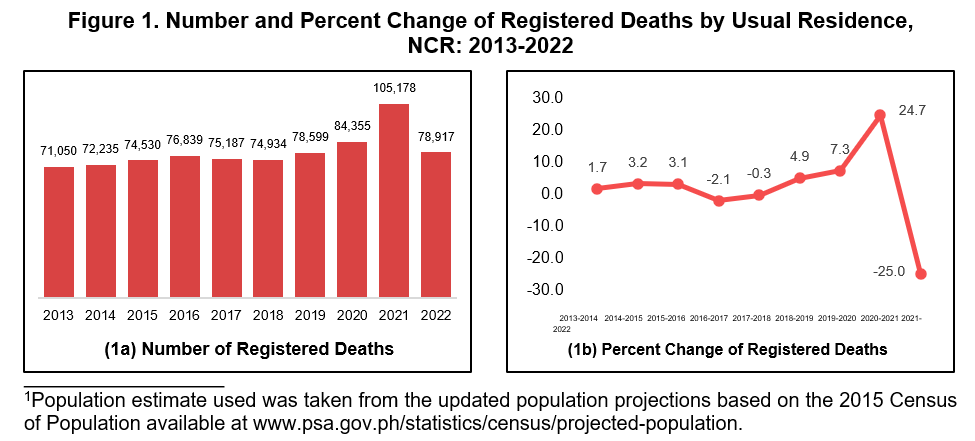
The number of registered deaths from 2013 to 2022 has trended upward except in the years 2017, 2018, and 2022. The increase during the ten years was 11.1 percent, from 71,050 in 2013 to 78,917 in 2022. (Figure 1 and Table 1)
One in every four deaths in NCR occurred in Quezon City
The highest number of registered deaths by place of occurrence was reported in Quezon City with 24,494 (27.1% share) followed by the City of Manila with 18,755 (20.8% share), and the City of Caloocan with 8,049 (8.9% share). The combined share of these three cities was 56.8 percent of the total registered deaths in the region. On the other hand, Pateros (286 or 0.3% share), City of San Juan (1,010 or 1.1% share), and City of Navotas (1,235 or 1.4% share) had the least number of total registered deaths in the region. (Figure 2 and Table 2)
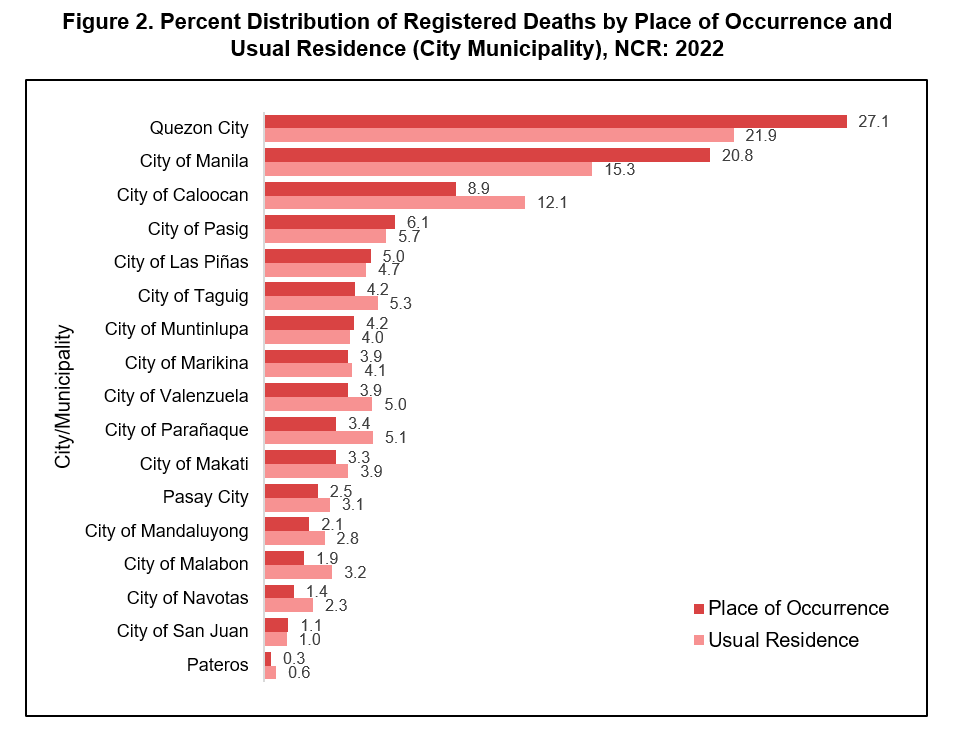
January had the most number of deaths
The average number of deaths registered per day was highest in January at 299, followed by the months of February and November at 279 and 273, respectively. Meanwhile, the month of May registered the lowest average death per day with 207. Figure 3 and Table 3)
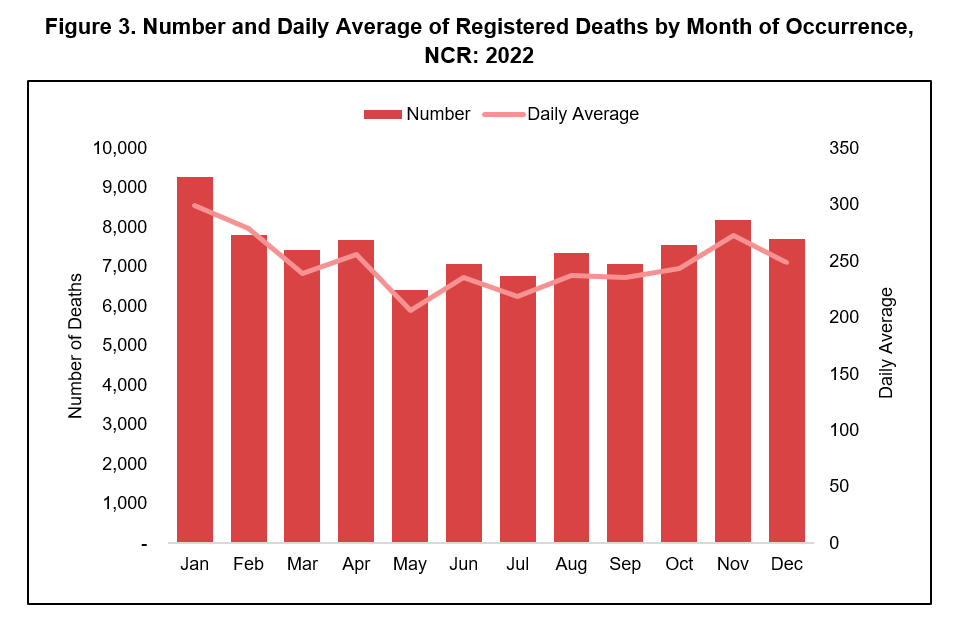
More male deaths than female deaths recorded
Figure 4 shows the age-sex structure of registered deaths by place of occurrence in 2022. It shows an inverted pyramid, with fewer deaths at younger ages, except for children under one, and progressively increasing as people grow older.
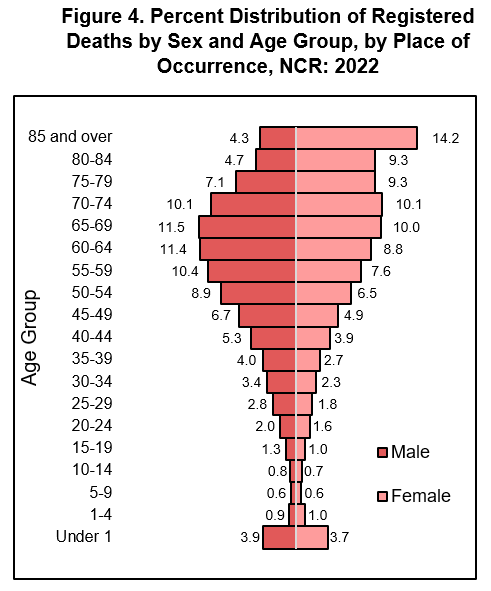
The number of registered male deaths in NCR (50,562 or 56.0% share) was higher than female deaths (39,749 or 44.0% share).
The proportion of males who died was highest at the age of 65 to 69 years old (5,814 or 11.5% of total male deaths) while for females, the largest was at the oldest age group, 85 years old and over (5,642 or 14.2 of total female deaths).
The sex ratio of 127 indicates that there were about 127 male deaths for every 100 female deaths. Moreover, a sex ratio of over a hundred means that more male deaths were registered compared to their female counterparts in every age group spanning 0 to 74 years. (Figure 4 and Table 4)
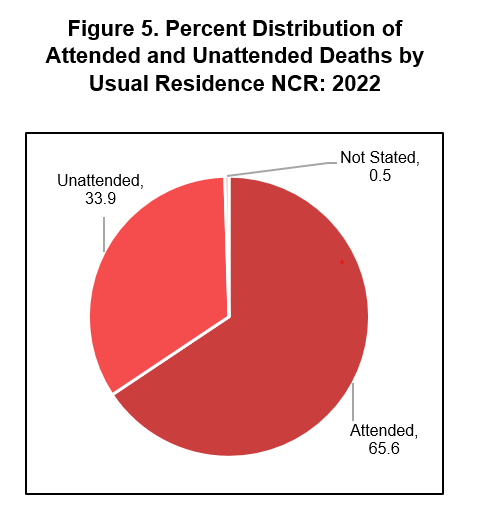
Seven out of ten deaths were attended by a healthcare provider
Attendant refers to a private physician, public health officer, hospital authority, or any other allied healthcare provider who provided medical attendance to the deceased.
Out of 78,917 registered deaths with usual residence in NCR, 65.6 percent were medically attended (by private physicians, public health officers, hospital authorities, and other medically trained professionals), and the City of Makati reported the highest percentage at 61.3. (Figure 5 and Table 5)
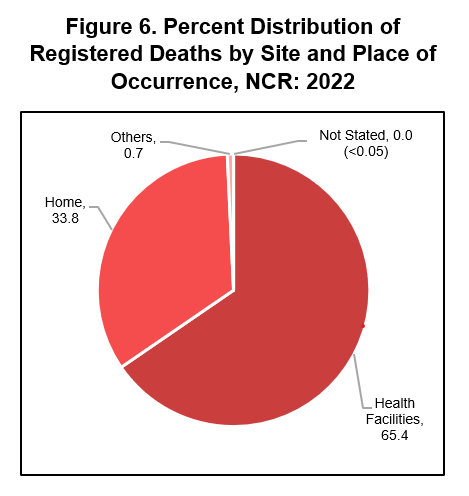
Three out of ten deaths occurred at home
Of the total registered deaths that occurred in NCR, 65.4 percent occurred in health facilities while 33.8 percent occurred at home, and about 0.7 percent occurred in places other than health facilities and homes, such as on the street, in public places, on board a vehicle, airplane or vessel while in transit, among others. Quezon City reported the highest percentage of deaths occurring in health facilities at 76.3 percent. (Figure 6 and Table 6)
Highest number of infant deaths recorded in Quezon City
Infant deaths are deaths that occurred before reaching age 1. A total of 2,780 infant deaths were reported with usual residence in NCR. This translates to an average of about 8 infant deaths per day. Six out of ten infant deaths were males (1,585 or 57.0% share). Cities with large populations topped the list with the highest number of infant deaths led by Quezon City (649 or 23.3% share), the City of Manila (375 or 13.5% share), and the City of Caloocan (304 or 10.9% share). (Figure 7 and Table 7)
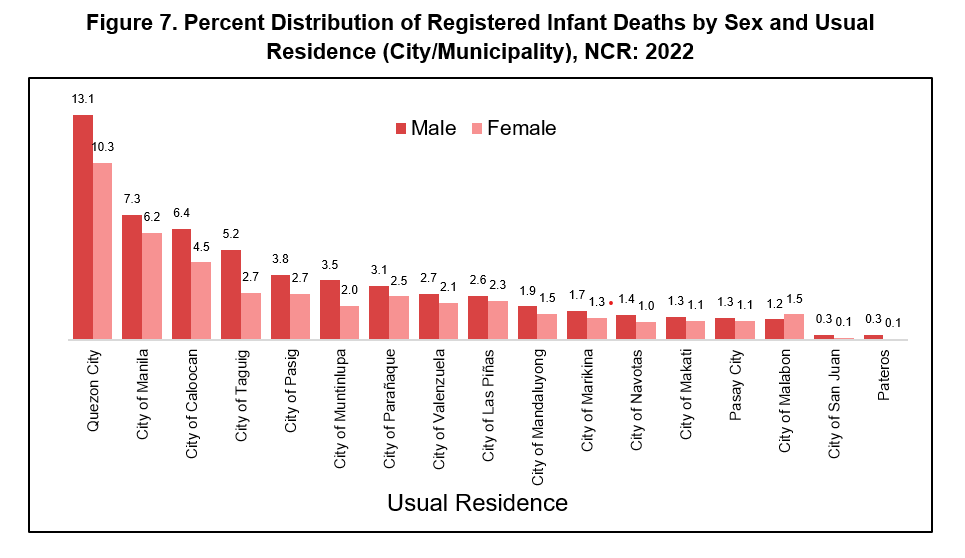
Highest number of maternal deaths was recorded in Quezon City
Maternal death is defined by the World Health Organization as, “the death of a woman while pregnant or within 42 days of termination of pregnancy, irrespective of the duration and the site of the pregnancy, from any cause related to or aggravated by the pregnancy or its management, but not from accidental or incidental causes.” A total of 279 were identified as having died of maternal causes in the region. Quezon City recorded the highest number of maternal deaths in NCR with 86 or 30.8 percent. On the other hand, the municipality of Pateros reported no maternal deaths by place of occurrence. (Figure 8 and Table 8)
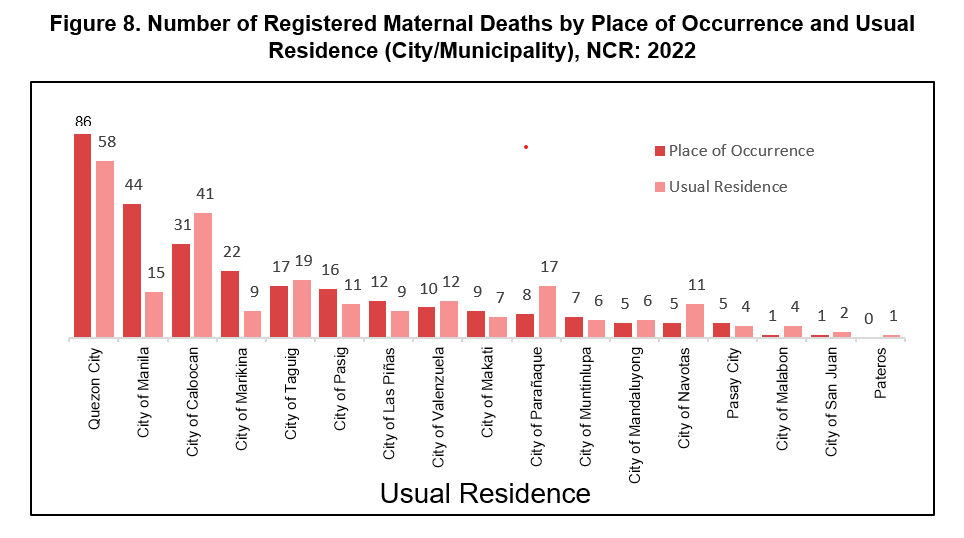
Quezon City recorded the highest number of fetal deaths
Fetal death refers to the death of a fetus irrespective of the duration of pregnancy prior to the complete expulsion or extraction of a product of conception from the mother’s womb. A total of 1,274 fetal deaths were reported. By usual residence of mother, Quezon City had the highest number with 335 or 26.3 percent followed by the City of Manila (167 or 13.1% share) and the City of Caloocan (117 or 9.2% share). (Figure 9 and Table 9)
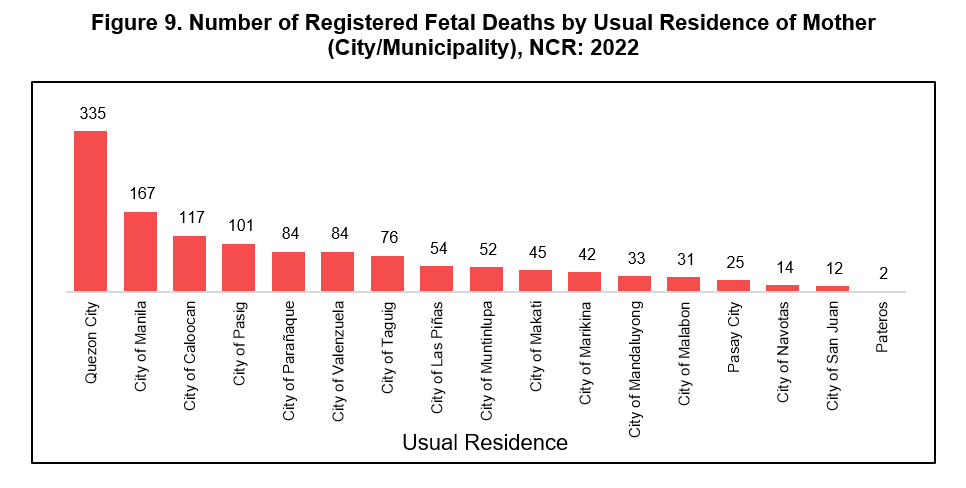
One in every four deaths in NCR is caused by Ischaemic Heart diseases
Deaths due to ischaemic heart disease led the cause of death making up 26.3 percent (23,769) of the total registered deaths by place of occurrence. This was followed by deaths due to Neoplasms at 13.1 percent (11,850), and Cerebrovascular Diseases at 8.7 percent (7,873). (Figure 10 and Table 10)
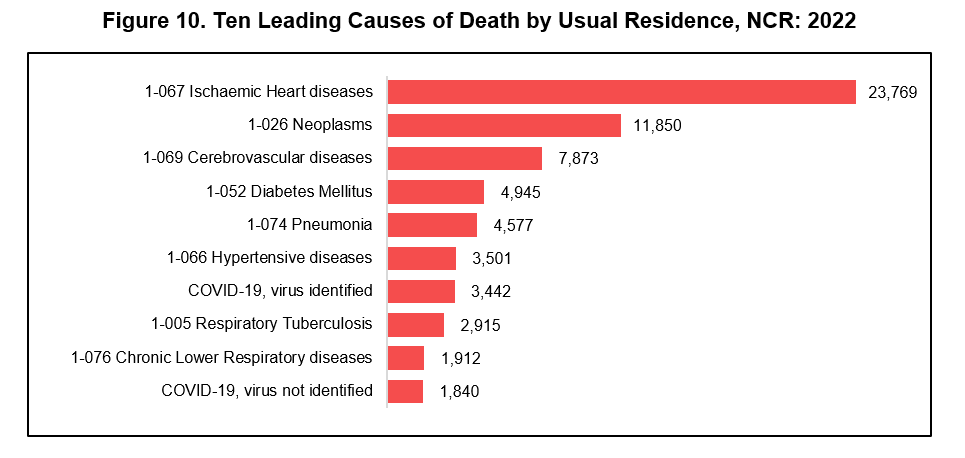
About 98 percent were registered on time
Registration of death shall be made in the office of the Civil Registrar of the city/municipality where the death occurred within thirty (30) days from the time of death. In 2022, 98.9 percent of deaths were registered on time while 1.1 percent were registered late. The Cities of Malabon and Navotas recorded the highest percentage of timely registration with 99.8 percent while the Quezon City recorded the lowest percentage with 98.1 percent. (Figure 11 and Table 11)
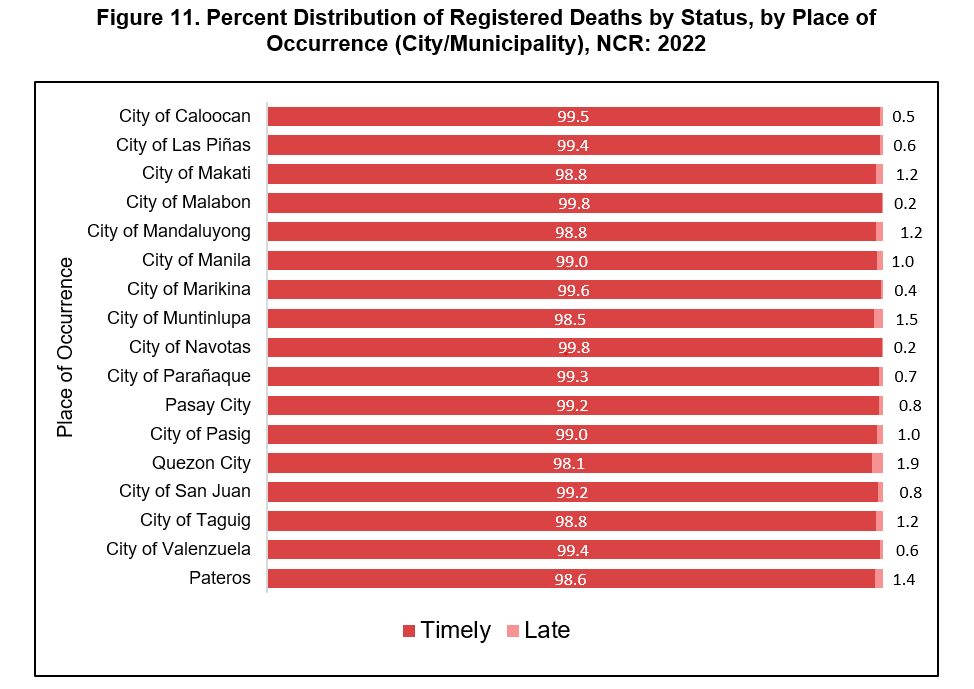
PACIANO B. DIZON
Regional Director
